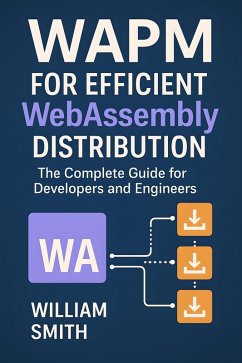
TinyGo for Embedded Systems and WebAssembly (eBook, ePUB)
The Complete Guide for Developers and Engineers

PAYBACK Punkte
0 °P sammeln!
"TinyGo for Embedded Systems and WebAssembly" "TinyGo for Embedded Systems and WebAssembly" is a comprehensive guide for engineers and developers eager to harness the power of Go in resource-constrained environments and next-generation web platforms. This book provides a meticulous exploration of TinyGo's architecture, language design, and compilation toolchain, illustrating how it bridges the gap between conventional Go programming and the demands of embedded systems and WebAssembly (WASM). It introduces newcomers to the project's ecosystem, development workflow, community-driven libraries, a...
"TinyGo for Embedded Systems and WebAssembly" "TinyGo for Embedded Systems and WebAssembly" is a comprehensive guide for engineers and developers eager to harness the power of Go in resource-constrained environments and next-generation web platforms. This book provides a meticulous exploration of TinyGo's architecture, language design, and compilation toolchain, illustrating how it bridges the gap between conventional Go programming and the demands of embedded systems and WebAssembly (WASM). It introduces newcomers to the project's ecosystem, development workflow, community-driven libraries, and best practices for robust project structure and efficient dependency management. The core chapters delve into real-world embedded development: configuring and programming hardware peripherals, managing I/O, handling interrupts, optimizing for memory and energy efficiency, and porting TinyGo to custom boards. It addresses advanced topics such as concurrency, real-time scheduling, and the unique constraints of embedded operating environments. The book also covers the full range of peripheral communication protocols, strategies for over-the-air updates, and techniques for testing, simulation, and debugging on both hardware and virtual platforms, equipping developers to build resilient, maintainable firmware. Expanding beyond microcontrollers, the book offers an authoritative treatment of TinyGo's WebAssembly capabilities, including JavaScript interoperability, browser API integration, system contexts via WASI, and best practices for packaging and deployment. Security is woven throughout, with thorough coverage of threat models, sandboxing, secure communications, and resilience against a wide spectrum of attacks. Through practical case studies-in areas such as Industrial IoT, Edge Computing, and serverless environments-the book not only demonstrates TinyGo's production impact but also highlights the community's path forward, making it an indispensable resource for innovators working at the intersection of Go, embedded hardware, and the evolving WASM landscape.
Dieser Download kann aus rechtlichen Gründen nur mit Rechnungsadresse in A, B, BG, CY, CZ, D, DK, EW, E, FIN, F, GR, H, IRL, I, LT, L, LR, M, NL, PL, P, R, S, SLO, SK ausgeliefert werden.













